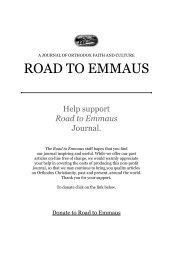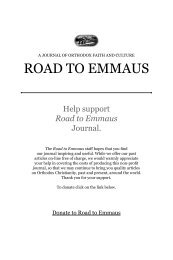RTE No 20 Interior - Road to Emmaus Journal
RTE No 20 Interior - Road to Emmaus Journal
RTE No 20 Interior - Road to Emmaus Journal
Create successful ePaper yourself
Turn your PDF publications into a flip-book with our unique Google optimized e-Paper software.
<strong>Road</strong> <strong>to</strong> <strong>Emmaus</strong> Vol. XII, <strong>No</strong>. 2 (#45)CROAGH PATRICKsaid, “I want <strong>to</strong> set you up as a small private foundation, with minimal funding,minimal interference, and a small team.” Since then we’ve done a numberof publications, surveys and excavations trying <strong>to</strong> enhance the archeologicalrecord, at the same time, putting it out <strong>to</strong> people that this is a hugelyimportant landscape in itself. Harry Hughes, the chairman and origina<strong>to</strong>r ofour group, has written a wonderful book called Croagh Patrick, A Place ofPilgrimage, A Place of Beauty.<strong>RTE</strong>: And what have you found there?MICHAEL: Gerry Bracken, who <strong>to</strong>ok the remarkable multiple exposure pho<strong>to</strong>sof the sun setting on the mountain, also flew the Reek when it was coveredwith snow. Snow is very rare here, but when it does happen, you get a fantasticlight. Jerry came one day <strong>to</strong> show me his wonderful pho<strong>to</strong>graph of the mountain,with the church in snow and the sea behind. I said, “Jerry, don’t mindthe church, look what the church is sitting in.” Of course, what it was sitting inwas, from the air, clearly a monastic enclosure.I managed <strong>to</strong> get a set of pho<strong>to</strong>graphs from 1905, when the present churchon the summit was built. There was a huge throng of people that year, becausethe pilgrimage was being revived as an official Catholic pilgrimage.In those pho<strong>to</strong>graphs, you could just pick out the early ramparts on eitherside, which have since been degraded by people taking s<strong>to</strong>nes for souvenirs.During the building of the 1905 church, the workers found a burial up there,which was interpreted as the grave of a famous 19th-century guide, Bob o’the Reek, who’d been buried on the summit, but almost certainly this gravewasn’t his. It was probably a much earlier cemetery that they’d dug in<strong>to</strong>.When we started working on the summit, we found a number of structuresthat we’d spotted from the aerial pho<strong>to</strong>graphy, one of which turned out <strong>to</strong>be a small ora<strong>to</strong>ry, which we excavated. The ora<strong>to</strong>ry was set within the widerenclosure, and outside of that, on the scree slope, we found about twenty huthollows dug in<strong>to</strong> the mountainside.<strong>RTE</strong>: These hut hollows were sites of monastic cells?MICHAEL: We don’t know. We excavated them through the scree and we gotsome artifact images, but the context wasn’t clear, so we’re still not sure.<strong>RTE</strong>: Were you able <strong>to</strong> date the ora<strong>to</strong>ry?MICHAEL: Yes, we’re pretty sure it’s from between the fifth <strong>to</strong> the eighth cen-tury, but we haven’t gotten any closer than that. It was a sunken ora<strong>to</strong>ry,sunken in<strong>to</strong> the hill, which makes sense when you’re up on this very steeppeak. The doorway faced east, and we have a number of early churches likethis. If you’d had the more normal western-facing door (with an eastern facingaltar) in this building you’d have just blown down the mountain. TeampallBenan, on <strong>to</strong>p of the hill at Cill Éinne on Aran, has a north-south orientation.It was an identical structure <strong>to</strong> ours in terms of size, shape, and theform of the building, which was a sort of corbelled, up-turned boat-shapedplan. So the ora<strong>to</strong>ry was a very important discovery, and we left the rest ofit unexcavated. Then we had <strong>to</strong> seal the whole thing off again because thesouvenir hunters and pilgrims got wind of it.There is evidence of this chapel’s existence recorded in 824 when theArchbishop of Armagh had an argument with the Archbishop of Tuam asArmagh was claiming church dues from Teampall Phadraig. This shows thatthe church on the summit was in use.<strong>RTE</strong>: Wouldn’t it make sense that the hut hollows in the scree were monasticcells for a community that worshipped in the ora<strong>to</strong>ry? The monks surelycouldn’t have made the climb from the bot<strong>to</strong>m every day.MICHAEL: I can say that after a couple of weeks of our team working upthere, we could climb Croagh Patrick in an hour. You get adapted, and I’msure the monks did <strong>to</strong>o. It’s arduous for us moderns because we aren’t used<strong>to</strong> hard physical work, but that’s something rather new. Before he emigrated,my father cycled seventeen miles <strong>to</strong> work every day and the same back, andthat wasn’t unusual. I do believe people were living on <strong>to</strong>p of Croagh Patrick,but for how long, we’re not sure. Another possibility is that the remote monasterieswere seasonal—perhaps they only lived there for part of the year.One of the other marvelous sites on the mountain we found with the helpof a local hill farmer. He couldn’t come up because he was <strong>to</strong>o elderly, so weclimbed down a thousand feet from the summit with him directing us fromthe bot<strong>to</strong>m. With his help we found a lovely remote monastic cell recessedin<strong>to</strong> the scree slope, looking out <strong>to</strong>ward the main pilgrimage route. It was anamazing site. This was probably a penitential cell, a private little spot.So now we have a confirmed major early-church site on <strong>to</strong>p of Croagh Patrick,and we have an his<strong>to</strong>rical account of the year 1113, when thirty peoplewere killed in a lightning strike while climbing the Reek on the night pilgrimage.We also have accounts of raids on the Reek.2627










